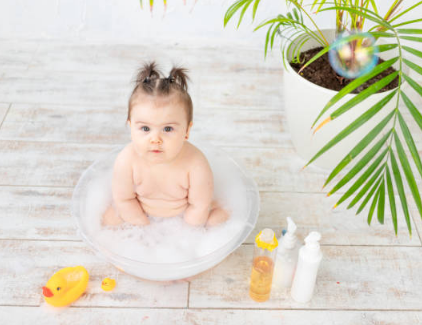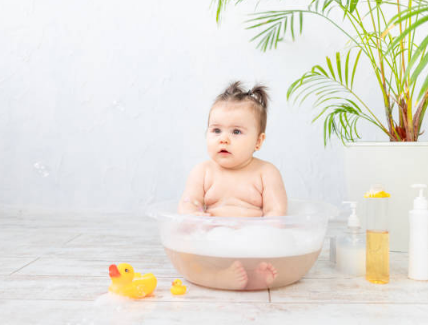Bathing your baby doesn’t look difficult… But like many things about parenting, knowing how and when to bathe your baby can be confusing! It’s not just well-meaning family members and social media offering outdated or conflicting bath time suggestions. A recent national survey found that hospitals are also offering a complete confusion of bathing recommendations. For example, researchers found that guidance on whether to use soap when bathing babies was both inconsistent and “potentially contradictory.” Ah. But here’s the thing: bathing your baby doesn’t have to be so anxious and confused! We’ve detailed everything you need to know to make sure your child stays clean and safe.

When to Bathe Your Newborn
Some parents think that they need to bathe their baby after birth. After all, things can get very messy during the delivery process! In addition to blood, mucus, and amniotic fluid, newborns are covered in a waxy white substance called vernix. (See below for more details.) But according to the World Health Organization (WHO), it’s best to postpone your baby’s first bath until 24 hours after birth, or at least six hours if it can’t be postponed longer due to cultural reasons. Studies have shown that 87% of hospitals follow this advice by delaying your baby’s first bath by at least six hours. This is good news because delaying your baby’s first bath can help prevent hypothermia, prevent your baby’s delicate skin from drying out, promote interskinual care, and promote early breastfeeding success according to the American Academy of Pediatrics (AAP). Additionally, a 2020 report found that delaying the first bath may even reduce violent crying in newborns. The only exception to the waiting bath rule: Babies whose mothers are HIV-positive or have hepatitis should be bathed after their initial breastfeeding (if breastfeeding) to reduce the risk to hospital staff and family members.
What Is Vernix?
Vernix (or simply vernix) is a thick, waxy white substance that coats babies inside the womb to protect their delicate skin from a moist uterus. Imagine if you were in the bathtub for nine months! Composed of 80.5% water, 10.3% lipids and 9.1% protein, vernix also acts as a lubricant to help your baby slide down the birth canal more easily during delivery. Vernix also has antimicrobial properties after birth. Scientists now know that vernix helps prevent infections and retains calories after birth. While your child will shed most of the layers that look like cream cheese before birth, some vernix will still be left behind. Premature babies, on the other hand, are usually coated with vernix as soon as they are born. (Learn more about vernix.)
Your Baby’s First Bath
Your baby’s first bath should be a sponge bath. In fact, you should bathe your newborn like this until the umbilical cord stump falls off and heals, which is usually within 15 days of birth. (Don’t be in a hurry!) It is important that you resist the urge to pull out the stump, even if it is dangling! Just let the residual limb fall off naturally. During a scrub bath, the baby’s body is in a bucket of water without submersion (even if partially submerged). Instead, make sure that the room where the newborn is bathed is about 75 degrees Fahrenheit, that there is no draft, that the baby’s umbilical cord stump is covered with gauze, and that the steps for giving your baby the first bath are as follows:
- Gather supplies. Prepare a towel, a mild, fragrance-free baby cleanser and shampoo, and two dry towels. One towel is used to wrap your baby, and the second towel is used to pad a hard surface that you may be bathing your baby.
- Prepare bath water. Fill a bowl with warm water.
- Wrap your naked baby in a towel. Then place your baby on a comfortable, flat surface, such as a changing table or floor. Make sure you always have at least one hand on your baby.
- Soak the towel in a bowl of water. Gently wipe your baby’s face and ears. Use the same cloth or cotton ball to clean your baby’s eyes, starting at the bridge of the nose and wiping them down to the corners of the eyes. (Baby cleaner is not needed at this time.)
- Consider using a baby cleaner. If desired, add some fragrance- and dye-free hypoallergenic baby cleanser to a water bowl or towel and start cleaning your baby’s neck, paying special attention to all their skin folds. According to the American Academy of Dermatology (AAD), you really only need to apply soap to dirty areas, such as neck creases and diaper areas.

- Rinse the soap after cleaning each baby area.
- Little by little, open your baby’s package. When ready, reveal the next part of your baby’s body to be washed while covering the rest of your baby with a towel. After cleaning each area, be sure to rinse off the soap. (The diaper area should be cleaned last.)
- Keep the umbilical cord stump dry. Avoid wetting your child’s umbilical cord stump.
- Rewrap your baby. After washing your baby’s body, re-wrap your clean baby with a warm towel before washing your baby’s scalp/hair.
- Wash your baby’s hair. Gently pour water over your baby’s scalp and wet their head, being careful not to let water get into their eyes. Next, squeeze a pea-sized amount of baby shampoo into your baby’s hair, carefully rub it in circular motions, and rinse off the shampoo with your hands.
- Dry your baby’s hair. Pat your baby’s hair dry and, if desired, comb through hair with a soft baby brush. (Baby hairbrushes can also help clear cradle cap.)
- Use a moisturizer. If your baby’s skin appears dry after bathing, apply a fragrance-free moisturizer to your baby’s skin 10 minutes after bathing. Additionally, if dry skin is a recurring problem, consider bathing your baby less often.
How Often Should I Bathe My Baby?
The AAD states that as long as your child’s diaper area is thoroughly cleaned during each diaper change, you will only need to bathe your child two to three times a week after you go home.
When Is Your Baby Ready to Bathe Regularly?
Once the umbilical cord stump has completely fallen off and healed (which usually occurs at two weeks of age), you can begin traditional bathing for your baby. (If the residual limb is still hanging over it at 2 months of age, talk to your baby’s pediatrician.) But remember, just because your baby is “ready” for a traditional bath, doesn’t mean they’ll love it! If your child is fussy and crying during regular bathing, feel free to resume sponge bathing for a while.
How Do I Bathe My Baby?
While some parents choose to use bathroom seats, the AAP warns that they are prone to tipping over and should be avoided. Instead, use a plastic baby bath with a sloping textured surface (or sling) to prevent your baby from slipping. While quality kitchen sinks are always an option, they are slippery and have obstacles like protruding faucets, so be very careful! (Running a clean towel in the sink or baby tub can help avoid slipping.) Here are some more tips on how to safely wash your baby in the bath:
- Keep the room ventilated. Make sure the room is warm enough so that the soaking wet baby doesn’t catch a cold. (Taken at about 75 degrees Fahrenheit.)
- Gather your supplies. Prepare a towel, a gentle and fragrance-free baby cleanser and shampoo, a small mug and a dry towel.
- Fill a baby bath or sink. About two inches of warm water is sufficient. Make sure the water feels warm on the inside of your wrist or elbow. (If you use a thermometer, make sure the bath water temperature is about 100 degrees Fahrenheit.)

- Hold your baby this Once your child is naked, support their head with one hand and guide them into the water with the other, feet first. (Because most of your baby’s body will be exposed to the water, you’ll need to regularly pour warm water over their body to keep them warm.) Never take your hands off your baby!
- Skip the baby facial cleanser. Gently cleanse your baby’s face without using baby cleanser. (Follow the same direction as a sponge bath.)
- Gently wash your baby’s body. From the neck down, wash your baby’s body with a mild, fragrance-free cleanser, making sure to clean all of your baby’s folds and rinse off the soap. GO. (Final cleaning of baby’s diaper area.)
- Keep a warm towel on hand. If your baby is cold, wrap them in a warm towel before tackling their scalp and hair.
- Wash your baby’s hair. Gently dampen your baby’s scalp with water (avoiding their eyes) and massage a pea-sized amount of baby shampoo into their scalp and hair. Cover your baby’s forehead with your hand to prevent soap from running down their face as you rinse the shampoo.
- Dry your baby. All done? Quickly wrap your baby’s head and body in a comfortable towel and gently pat dry. Once dry, consider using a small amount of fragrance-free, hypoallergenic moisturizing lotion if your baby’s skin seems dry. (Bathing your baby sparingly can also help dry out the skin.)
How Should I Bathe My Baby with Eczema?
If your baby has been diagnosed with eczema (also known as atopic dermatitis), which manifests itself as dry, itchy skin, seek guidance from your pediatrician and/or pediatric dermatologist. They may suggest the following:
- Take a 5- to 10-minute warm bath every day or every other day. (Water that is too hot and baths that are too long can exacerbate eczema symptoms in infants.)
- Use mild, hypoallergenic baby cleaners that are free of soaps, fragrances and dyes only on soiled areas such as hands, feet, baby’s neck folds and diaper areas. Plain water is fine for the rest of baby’s body.
- Rinse baby cleaner off your baby’s body as you go.
- After bathing, apply moisturizer to your child’s body while their skin is still damp. Ointments such as Vaseline or fragrance-free moisturizers are good choices. Lotion is less effective when it is too thin. (Moisturize your baby’s delicate skin about twice a day.)
- It is wise to dress your baby in soft, natural fabrics such as 100% organic cotton and use only mild, fragrance-free laundry detergents.
